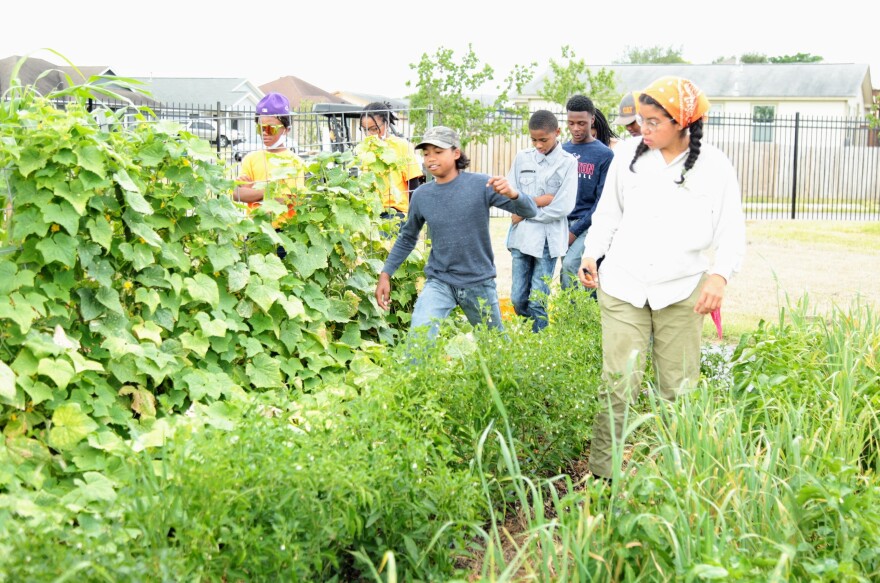A new report on urban agriculture in San Antonio suggested the placement of urban farms and food forests on underutilized public natural land would increase high-quality food access to areas with food insecurity.
The report was based on the San Antonio Urban Agriculture Analysis. Researchers from the Natural Capital Project at Stanford University performed case studies on three existing food forests in San Antonio to examine the benefits of urban agriculture at a district level.
A food forest is a low-maintenance, self-sustaining system of crops designed to mimic a natural forest.
Based on the case studies, researchers recommended the city consider using vacant public land for urban agriculture city-wide. Anne Guerry, the chief strategy officer and lead scientist for the Natural Capital Project, presented the analysis to the city’s Community Health, Environment, and Culture Committee in late May.
“Of course, we’re not proposing that that is something that one would do, but it gives us an estimate of what could be produced on these lands,” she explained.
One of the food forests studied was Tamōx Talōm Food Forest at Padre Park on the South Side, a project of the Food Policy Council of San Antonio (FPCSA). The council, a nonprofit dedicated to improving access to fresh, healthy, affordable food, and several city offices worked with the Natural Capital Project on the analysis.
The Tamōx Talōm Food Forest was planted in 2021 and is not producing fruit yet. But once the forest matures, it has the potential to provide each of the 473 households relying on SNAP benefits in its census tract with 3/4 pounds of fresh fruit and nuts per week, according to the analysis.
In April, over 120,000 individuals were enrolled in SNAP food benefits in Bexar County, according to the Texas Department of Health and Human Services.

“There’s a lot of different comprehensive planning processes that the Food Policy Council has been involved with through the years that have concluded that urban agriculture and food insecurity are important things for the city to tackle,” Mitch Hagney, the chair of FPCSA’s Urban Agriculture Committee said.
In 2020, District 6 Councilwoman Melissa Cabello Havrda filed a council consideration request asking the city council to identify City Code barriers to urban farms. It received four supporting signatures, and the City Council’s Governance Committee established a task force to explore laws that could be changed for urban farming.
Currently, there are approximately 51 acres dedicated to urban farms and large community gardens, like the San Antonio Food Bank, across Districts 1, 2 and 6, and about 72 acres of urban food forests in Districts 2 and 3, according to the analysis.
In March, Villa Coronado Park on the South Side became the site of another food forest as a project of the city’s Metropolitan Health District and Parks and Recreation Department. According to the Stanford analysis, 50% of households in the park’s surrounding area are low-income, and 23% of them rely on SNAP food benefits.
The researchers estimate the food forest will produce more than $500,000 worth of food per year with proper maintenance. Food forests can also address the city’s environmental concerns such as heat islands, climate change, green space access and flood retention.
“Currently, one in five children in San Antonio lack access to healthy foods, and at the same time a lot of those same children are in dense urban areas that suffer from really high urban heat indexes,” Hagney said. “At the same time, those same regions of the city … really struggle with risks of flash flooding, and we think that these environmental and health concerns are linked.”
District 5 Councilwoman Teri Castillo said she would like to see food forests expand to her district, which the Stanford study examined. It has the lowest availability of publicly-owned natural areas for urban agriculture use and the highest percentage of households receiving SNAP benefits.
“There are so many compounding disparities in District 5, and this is the kind of initiative that we need to work towards and implement,” Castillo said. “District 5 has a wealth of vacant lots that are just lost to the process. … I see opportunity for some of that land to become public land to take on innovative projects like this.”
Researchers made several policy recommendations for San Antonio’s urban agriculture. They included expansion of the city’s Community Toolshed to include urban agriculture tools like tillers, tree augers and walk-behind tractors; making certain public lots available for long-term leasing to urban farmers; and integrating food forests into publicly managed land such as parks and floodplains.
San Antonio is a pilot city in the Natural Capital Project’s development of a user-friendly web-based tool for urban planners to select a land parcel in their district and see the effects of different types of land usage.
Members of the Community Health, Environment, and Culture Committee hope to incorporate funding for urban agriculture initiatives in the city’s next budget.
“I think we should be having this conversation during the budget conversations for 2024 that are ongoing right now for a number of reasons,” Castillo said. “We’re running out of time, and in order to bear the fruit of the food forests, we need to get started ASAP.”


